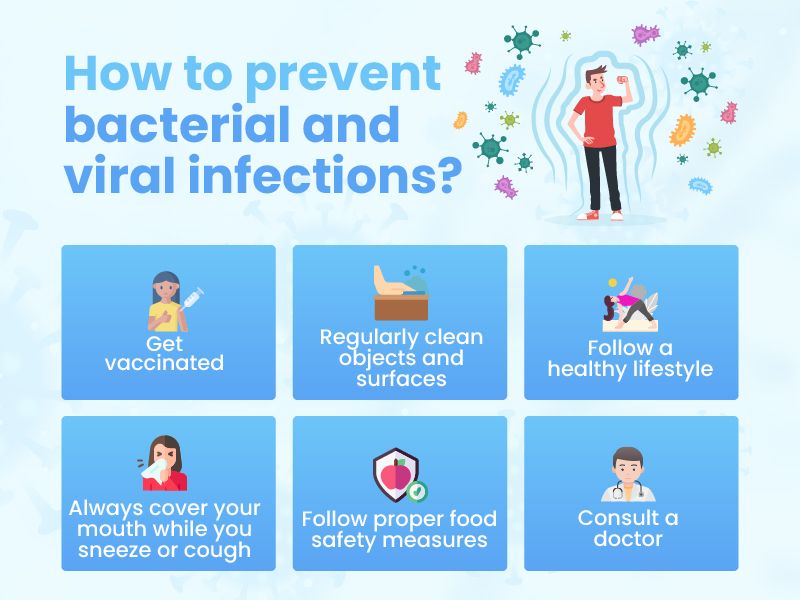Bacterial And Viral Infections On The Peak: Stay Safe!
30 months ago
4 minute read.

In our daily lives, we encounter numerous microorganisms that can cause infections. Among them, bacteria and viruses are the most common culprits. These tiny, invisible organisms can wreak havoc on our health, leading to illnesses.
In the face of an ever-evolving world, the realm of infectious diseases remains an ever-present challenge for humanity. From the rapid spread of highly contagious viruses to bacteria, the threat of bacterial and viral infections looms large and continues to capture the attention of both the scientific community and the general public.
In recent times, the world has faced unprecedented challenges in dealing with bacterial and viral infections. The emergence of new strains, coupled with global travel and interconnectedness, has led to outbreaks and pandemics that have impacted millions of lives. In this blog, we will explore the differences between bacterial and viral infections, their symptoms, transmission methods, and essential precautions to stay safe during these challenging times.
How are bacteria different from viruses?
Viruses and bacteria are microscopic and invisible to the naked eye. Although they can cause similar symptoms and spread through similar means, they differ significantly in other aspects.
Bacteria are single-celled organisms with a cellular structure, reproduce independently, have their metabolism, and can be targeted by antibiotics. Viruses are much smaller, lack cellular structures, depend on host cells for replication, and are unaffected by antibiotics.
Bacteria have a broader host range and can cause various diseases, while viruses have a narrower host range and cause viral infections. Bacteria play beneficial and harmful roles, while viruses are mainly associated with diseases.

Bacterial infections vs. viral infections
Determining the cause of infection can be challenging due to the similarity of symptoms between viral and bacterial infections. To identify the specific type of infection, medical professionals often require samples such as urine, stool, blood, or swabs from the nose or throat for further analysis. Distinguishing between bacterial and viral infections is crucial because the treatment approaches differ significantly.
Various bacterial infections exist, including whooping cough, strep throat, ear infections, and urinary tract infections (UTIs).
Viral infections include conditions such as the common cold, influenza, many types of coughs, bronchitis, chickenpox, monkeypox, COVID-19, and HIV/AIDS.
|
Bacterial Infections |
Viral Infections |
|
|
Cause |
Caused by bacteria |
Caused by viruses |
|
Structure |
Complex cells with cell walls |
Smaller and simpler, with a protein coat and genetic material |
|
Reproduction |
Can replicate on their own |
Require a host cell to reproduce |
|
Treatment |
Can be treated with antibiotics |
Cannot be treated with antibiotics |
|
Symptoms |
Fever, localized pain/swelling, pus formation, inflammation |
Cough, runny nose, sore throat, fatigue, fever, body aches, malaise |
|
Examples |
Strep throat, urinary tract infections, tuberculosis |
Common cold, influenza (flu), HIV/AIDS |
Symptoms of bacterial and viral infections
Bacterial Infections
- Fever
- Localized pain
- Inflammation
- Coughing
- Difficulty breathing
- Fatigue
- Malaise
- Gastrointestinal issues (diarrhea or vomiting)
Viral Infections
- Fever
- Fatigue
- Headache
- Muscle aches
- Sore throat
- Coughing
- Congestion
- Runny nose
- Sneezing
- Gastrointestinal symptoms (nausea, vomiting, and diarrhea)
Treatments for bacterial and viral infections
Treating viral infections
There is no specific treatment for many viral infections, as they often resolve with time. Focus on relieving symptoms and supporting your body's natural healing process. Some things that can help are:
- Stay hydrated by drinking plenty of fluids to prevent dehydration.
- Get enough sleep so your body can heal.
- Over-the-counter pain medications like acetaminophen (Tylenol) or ibuprofen (Motrin, Advil) can help relieve aches, pains, and fever.
- Over-the-counter decongestants can provide relief for a runny or stuffy nose.
- Soothe a sore throat by using throat lozenges or gargling with warm saltwater.
Also check: 8 ayurvedic remedies to keep infections at bay this monsoon
Treating bacterial infections
- Bacterial infections are typically treated with antibiotics, which are medications that specifically target and kill bacteria. The choice of antibiotic depends on the type of bacteria and its susceptibility to specific drugs.
- To promote the body's ability to recover and reduce pain, supportive care practices like rest, hydration, and symptom control may be advised.
Note: Consulting a healthcare professional is recommended for appropriate diagnosis and treatment guidance.

What’s the best way to prevent bacterial and viral infections?
The best way to prevent bacterial and viral infections involves a combination of personal hygiene practices, vaccination, and adopting a healthy lifestyle. Some measures you can take are:
- Vaccination: Stay up to date with recommended vaccinations. Vaccines are available for many common bacterial and viral infections, such as influenza, measles, mumps, rubella, hepatitis, and pneumococcal diseases. Consult with your healthcare provider to ensure you are appropriately vaccinated.
- Respiratory hygiene: When you cough or sneeze, make sure to cover your mouth and nose using a tissue or your elbow. Afterward, dispose of the used tissues correctly and remember to wash your hands. If you do not have a tissue, cough or sneeze into the crook of your elbow rather than your hands.
- Clean and disinfect: Regularly clean and disinfect frequently-touched objects and surfaces, such as doorknobs, light switches, cell phones, and countertops. Use appropriate disinfectants and follow the instructions on the product labels.
- Practice safe food handling: Follow proper food safety measures, such as cooking food thoroughly, avoiding cross-contamination of raw and cooked foods, and refrigerating perishable items promptly.
- Maintain a healthy lifestyle: A powerful immune system can aid infections. Focus on maintaining a balanced diet, exercising regularly, getting sufficient sleep, managing stress levels, and avoiding smoking or excessive alcohol consumption.
- Practice safe sex: Using condoms or other barrier methods and limiting sexual partners can reduce the risk of sexually transmitted infections (STIs).
Conclusion
Bacterial and viral infections continue to pose significant health risks, demanding our utmost attention and adherence to preventive measures. By understanding the nature of these infections, recognizing their symptoms, and implementing necessary precautions, we can protect ourselves and others. Remember, your actions matter in breaking the chain of transmission.
Leave a Comment
Related Articles
Health Checks @ Home
Service
Explore
© 2026 Truworth Health Technologies Pvt. Ltd.




